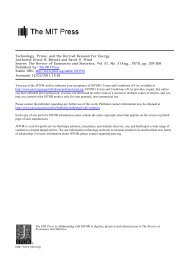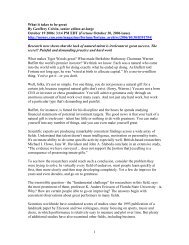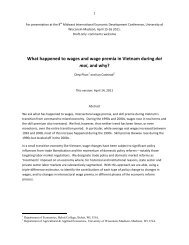Capital-Labor Substitution and Economic Efficiency Author(s): K. J. ...
Capital-Labor Substitution and Economic Efficiency Author(s): K. J. ...
Capital-Labor Substitution and Economic Efficiency Author(s): K. J. ...
You also want an ePaper? Increase the reach of your titles
YUMPU automatically turns print PDFs into web optimized ePapers that Google loves.
CAPITAL-LABOR SUBSTITUTION AND ECONOMIC EFFICIENCY 2 43<br />
Table 5 for which relative commodity prices<br />
are also available.<br />
In manufacturing, the median efficiency level<br />
is .43 (or .35 weighted by value added) which is<br />
about the same as the average ratio of Japanese<br />
<strong>and</strong> American efficiency determined in section<br />
III.23 In primary production it is considerably<br />
lower, with agriculture <strong>and</strong> coal mining only<br />
one seventh of the American level.<br />
Three factors may be suggested to explain<br />
these differences in relative efficiency.<br />
(i) Limited natural resources doubtless ex-<br />
plain a large part of the lower efficiency of capi-<br />
tal <strong>and</strong> labor in primary production in Japan.<br />
(ii) Competitive pressure in exports <strong>and</strong><br />
import substitutes was suggested in [6] to be<br />
a cause of more rapid productivity increases in<br />
these sectors in Japan. Inefficient sectors (agri-<br />
culture, mining, food, non-metallic mineral<br />
products) produce for the home market in<br />
Japan <strong>and</strong> are protected by either transport<br />
costs or tariffs from foreign competition.<br />
(iii) Relatively efficient sectors in Japan<br />
(petroleum products, coal products, steel, non-<br />
ferrous metals) are characterized by high capi-<br />
tal intensity, large plants, <strong>and</strong> continuous proc-<br />
essing. There may be technological reasons why<br />
it is easier to achieve comparable efficiency lev-<br />
els under these conditions.<br />
Tests of these <strong>and</strong> other hypotheses regard-<br />
ing relative efficiency must await similar studies<br />
for other countries.<br />
2. Relative commodity prices. Since we now<br />
have estimates of all three parameters in the<br />
production function, we can investigate their im-<br />
portance to the determination of relative com-<br />
modity prices.<br />
To do this, we substitute representative val-<br />
ues of wlr 24 for the United States, Western<br />
Europe, <strong>and</strong> Japan in formula (28):<br />
| (__) __<br />
A 1_<br />
P B W-8 YA ( A(WB A<br />
23 None of the four examples in section III corresponds<br />
very well to the larger industries used here; the main differ-<br />
ence in yJ/yu is in steel, which shows a much lower efficiency<br />
in Table 3.<br />
24 Values of w/r assumed are: United States, 2I.3; Eu-<br />
rope, 5.o; Japan, I.42.<br />
-<br />
<strong>and</strong> use it to construct curves of constant rela-<br />
tive prices (isoprice curves). As indicated in<br />
section II-D-6, prices in our analysis refer only<br />
to the direct cost of labor <strong>and</strong> capital. Three<br />
such curves are shown in Chart 4. Curve I<br />
CHART 4. - EFFECTS OF C AND 8 ON RELATIVE PRICES<br />
1.8<br />
1.6<br />
14 -<br />
CIllrIE<br />
I<br />
LOWER PRICES IN<br />
HIGH-WAGE COUNTRY<br />
1.2xA<br />
pB rB<br />
COMPARISONS P tA<br />
1.0 x B OF: A4<br />
I -JAPAN-U.S. .333<br />
\II-JAPAN-US. .17 7<br />
II\EUROPE-US. M<br />
.3 33<br />
.8 C ;x<br />
.2-<br />
HIGHER<br />
PRICES IN<br />
HIGH-WAGE<br />
COUNTRY<br />
xD<br />
.1 .2 4 .6 .8 1.0<br />
assumes the typical efficiency ratio of .33 be-<br />
tween Japan (B) <strong>and</strong> the United States (A),<br />
<strong>and</strong> equal prices. However, the average ratio<br />
of Pj/Pu actually calculated for the manufac-<br />
turing sectors in Table 7 is about .53, a value<br />
which is illustrated by curve II. Since changes<br />
in efficiency have the same effect as changes in<br />
relative prices, however, curve II can also be<br />
interpreted as a line of equal prices <strong>and</strong> relative<br />
efficiency of .i8. Curve III corresponds to<br />
curve I for the Europe-United States compari-<br />
son, with an efficiency ratio of .33 <strong>and</strong> equal<br />
prices.<br />
The general principle illustrated by Chart 4<br />
is that high values of 8, a-, or the YA 71B ratio<br />
lead to lower prices in the high-wage country<br />
(A). A higher value of o- can offset a low value







